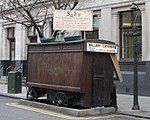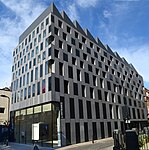The Clerk's House
Architecture stubsGrade II listed houses in LondonHouses completed in 1735Shoreditch

The Clerk's House is an historic building in Shoreditch, England. Standing at 118½ Shoreditch High Street, it is a Grade II listed building dating to 1735. It is two storeys, plus an attic and a basement. Part of its interior, such as some wood panelling, dates to the 16th century.Believed to have formerly been a watch house, from which somebody looked out for body snatchers in the adjacent St Leonard's churchyard, the ground floor is now a business, while the upper floors remain residential.
Excerpt from the Wikipedia article The Clerk's House (License: CC BY-SA 3.0, Authors, Images).The Clerk's House
Shoreditch High Street, London Shoreditch (London Borough of Hackney)
Geographical coordinates (GPS) Address External links Nearby Places Show on map
Geographical coordinates (GPS)
| Latitude | Longitude |
|---|---|
| N 51.5267793 ° | E -0.077758 ° |
Address
The Clerk's House
Shoreditch High Street 118 1/2
E1 6JE London, Shoreditch (London Borough of Hackney)
England, United Kingdom
Open on Google Maps




